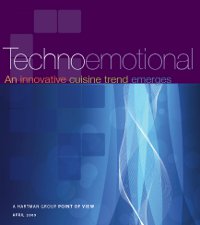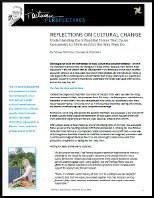Reflections on Cultural Change
By Harvey Hartman, Founder & Chairman
Working as we do at the intersection of food, culture and consumer behavior, I believe it’s important to always track key dialogues in these arenas. Because many believe these discussions — and the people seen as shaping them — will eventually trickle down to affect consumer behavior at a mass scale. But what if these debates can themselves be rolled up into larger shifts in contemporary culture? Rather than simply listening to our experts and pundits, wouldn’t it be more important to understand the forces that cause them to think and act the way they do?
The Past, the Here and the Now
I believe the single most important food trend of the past thirty years has been the rising consumer interest in fresh, less processed food. For many — be they experts, manufacturers, marketers or consumers — this can be expressed most simply by “processed = bad; fresh, less processed = good.” Of course, all of us in this business are always seeking the nuances, the keener understanding that yields competitive advantage.
To this end, we’ve long championed the position that fresh, less processed is but one part of a larger cultural trend toward the redefinition of food quality, which includes drivers like more distinctive ingredients and flavors, local, seasonal, artisanal and so forth.
Often people speak of Alice Waters as one of the leading lights of the fresh, less processed trend, as well as the resulting cultural shift that encompassed it. Utilizing her now-famous restaurant Chez Panisse as a springboard, Waters pioneered — and politicized — a new way of thinking about food that chose as its motif the romance of an imagined, premodern past. I use the word imagined because few of us are old enough to really know what food production, preparation or eating was like “back then.”
 This then begs one of the most common questions I get: So why should I be paying attention to all of this?
This then begs one of the most common questions I get: So why should I be paying attention to all of this?
Writing for Slate, Emma Marris observes:
“By focusing on the local, Chez Panisse sought to establish itself outside of, and as a challenge to, the industrial food system. Sensitive to the charge that hers was a cuisine for the rich, Waters launched programs to bring organic gardens to schools serving underprivileged youth. More recently, she and Michael Pollan have led efforts to cut federal subsidies to conventional agriculture and to increase public support for organics and farmers markets.
Today, it is Waters’ world: We all just cook in it. So successful was her recipe for authentic food that the values she braided together into Chez Panisse’s winning formula — fresh, local, seasonal, sustainable, traditional, and simple — now seem inseparable.”[1]
At first glance, the spoils of Waters’ victory can be found in the many thousands of food trucks and farmers markets that populate the world around us. And in the many millions of consumers believed to now be demanding that their canned beans be local, whatever that means.
But has Waters’ or Pollan’s vision for American eating habits ever really been realistic? And have consumers ever been putting these ideas into practice in the way Waters intended? We surely love our farmers markets, but are we there to trace the relationship of our food to its source, or do we just like to wander in the sunshine while buying some groovy-colored honey and a slice of pizza from a guy with a pizza oven hitched to his bicycle?
From a contemporary cultural perspective, our ideas about what constitutes a higher-quality food experience seem much better suited to making sense of purple-hued honey and bicycle pizza than a strident philosophy that positions local food products as the de facto option.
The Now, the There and the Future
Recently there has been a new voice emerging that has been cast as something of an alternative to Waters. This voice doesn’t seem to be about food that is better for you or the planet, or even tastier; it just speaks of food differently.
Specifically, chefs such as Daniel Patterson and René Redzepi, whose restaurant Noma is thought by many to be the best in the world, are channeling a more contemporary ethos as they choose playfully from elements of our premodern, modern and postmodern worlds. And because they are not stuck in a romantic dream of the past, they are free to tinker with technology as well.
Unlike Waters, these chefs are not strictly bound by a reverence for place or tradition or the conventional thinking that calls into question cuisines not crafted from the stuff of gardens. As Redzepi describes one dish of dehydrated scallop chips on boiled grains:
“We’d made a dish with no reference points in the past nor in other lands”
To be clear, these folks maintain an unwavering focus on cooking with great ingredients. But their foundational culinary skills give them great freedom to experiment. They are perfectly comfortable using the full suite of tools and technology available to them to transform ingredients from the wild into more palatable creations. Oddly enough, they believe that this very technology gives them access to the essence of a natural ingredient at a level not possible by eating a carrot from Alice’s garden — be it orange, purple or otherwise.
Marris again:
“Patterson and Redzepi use tools and techniques that are unavailable to the home cook, including Pacojets, which blend frozen things; Thermomixes, which heat and puree simultaneously; commercial-grade food dehydrators; and dry ice. Their claim, embodied in their dishes, is that these nontraditional, advanced technologies can take us closer to the essential experience of an ingredient.”
As hinted above, this postmodern stance — which encourages the use of technology, eschews politics in favor of creativity and encourages us to ask not “how should” but “what if” — may seem incompatible with conventional perspectives on sustainability. But this needn’t be the case. Because as our culture continues to evolve, so too will our perspectives on sustainability. Back to Marris:
“If the message from the new generation might not be as clear as Waters’, that very ambiguity may be valuable. They begin by teaching us that we can eat well — very well — without relying on the Chez Panisse formula. They hint at other solutions to the problem of ethical, green, appetizing food, solutions that don’t rely on an impossible-to-scale return to a romanticized version of our agrarian past. One could imagine a cuisine, for instance, that is sustainable but not local. In fact, one might want to imagine such a thing: fresh-sustainable-innovative-technological-global.
These chefs’ food is about the future, a future both highly technological and wilder than our world today, where our relationship to nature is closer and more delicious than ever.”
If we have positioned the Waters philosophy as increasingly less relevant to evolving trends in food culture, we need to also acknowledge the fact that few consumers currently have any idea who Patterson or Redzepi are or what it is they are doing. The reality is that our consumer is somewhere between, searching for meaning in a world beyond recycling but not yet globally local.
This then begs one of the most common questions I get: So why should I be paying attention to all of this?
At the risk of sounding simplistic, wouldn’t you want to be out ahead of the curve? To be building the foundations to great brand and retail legacies while your competitors are heads down in the trenches of today, struggling for relevance in an increasingly crowded marketplace?
It’s ironic that while Alice was tending to her peas at Chez Panisse, the original owners of Starbucks — Zev, Gordon and Jerry — were busy roasting their beans. Both first opened their doors in 1971. By comparison, Whole Foods was a relative latecomer to all of this, first emerging in 1984. One wonders where A&P would be today if they had the audacity to align themselves with those developments in the early 1980s.
What Can Culture Teach Us About This?
If you’ve gotten this far, you may well choose to accept this summary at face value and be content moving forward with a deeper understanding of contemporary food trends. And that’s a good thing.
But what about the folks looking for the true competitive advantage described above? The kind of deeper understanding that will fuel successful innovations strategies — both near and long term?
Let’s begin by thinking about Alice, René and Daniel and their teachings. These folks are not gods. They didn’t drop from the heavens with special powers and rainbow auras. They’re just ordinary people like us who have been pushed into the spotlight because their work happened to align with a certain cultural moment.
As it happens, the evolving trajectory of these cultural moments in the worlds of food and eating align almost perfectly with everything we’ve been witnessing in the broader cultural transformations in American society.
As we transition from the more traditional production economies of the recent past to the truly globalized economies of a postmodern world, René’s and Dan’s perspectives on sustainability are evolving in lockstep. They are reimagining local from the literal to the metaphoric, a local that pragmatically recognizes the realities of a globalized way of life.
If Alice Waters’ philosophies on food production and consumption reflected the growing skepticism of technological solutions espoused by 60s- and 70s-era political ideologies, René’s and Dan’s beliefs are more in tune with a contemporary culture that has welcomed technology into every facet of our present life.
Our newly democratized technology is no longer a battlefield of political ideology; it is there to make of it what we wish. We may decide to engage in a public debate about the limits of government intrusion into our electronic communication, but nobody is questioning our right to own the devices that transmit those voice or text messages. And the same is true for the production technologies once governed by a small handful of multinational corporations. It’s much less interesting to whine about what manufacturers are doing with their tools when we can just buy 3D printers or food dehydrators and do things as we see fit. The point here is not that all consumers are going to start making their own processed foods. Rather, the mere fact that we can compels us all to embrace technology with an openness of spirit and more pragmatic skepticism. The Waters-inspired mantra of “screwing with things is bad” is replaced by “screwing with things may be bad, but let’s screw with them ourselves and find out.”
 Can you now begin to see that what we are learning about cultural change might give us better insight into current consumer trends? Maybe it’s the case that the consumer fascination with canning, pickling or heirloom fruits is as much about messing around with stuff as it is listening to the disciples of Waters. And as long as we’re messing with stuff, let’s see what René has been cooking up…
Can you now begin to see that what we are learning about cultural change might give us better insight into current consumer trends? Maybe it’s the case that the consumer fascination with canning, pickling or heirloom fruits is as much about messing around with stuff as it is listening to the disciples of Waters. And as long as we’re messing with stuff, let’s see what René has been cooking up…
We looked at these issues in much greater detail in a white paper we published in 2009, Technoemotional: An Innovative Cuisine Trend Emerges, which highlighted the coming role technology would be playing in contemporary eating habits. Those conclusions and implications are as relevant today as they were then, in large part because they were grounded in culture.
Conclusions for Food Manufacturers, Marketers and Branders
So here is what you should be thinking about today:
STOP PENDULUM-SHIFT THINKING: Avoid the common tendency toward a revolutionary perspective on trends — the idea that new trends must, by definition, refute previous or current trends.
DON’T ABANDON FRESH & QUALITY: As professional chefs — and increasingly consumers — begin to tinker with the application of food science technology to provide higher-quality food experiences, do not mistakenly assume that the trend toward “all things fresh, local and seasonal” will subside. The trend toward higher-quality ingredients — and, by proxy, food experiences — will continue unabated.
RETHINKING TECHNOLOGY: If you are in the CPG business, consider how your technology can be used to create the “highest-quality food experience” possible. So rather than settling on now-dated notions of technology as a driver of efficiency, predictability or homogeneity (or a tool for scalability), why not reconceptualize technology as a tool useful for creating more unique, compelling, customized food experiences?
REDEFINITION OF QUALITY: The sum total of ideas, preferences, desires, techniques and “ways of doing” that have characterized trends in the food world for the past 30 years (be they about all things fresh and local or all things technological) point to one inescapable conclusion: The overriding impulse is toward the redefinition of quality — the foundational restructuring of what it means to enjoy a quality food experience.


